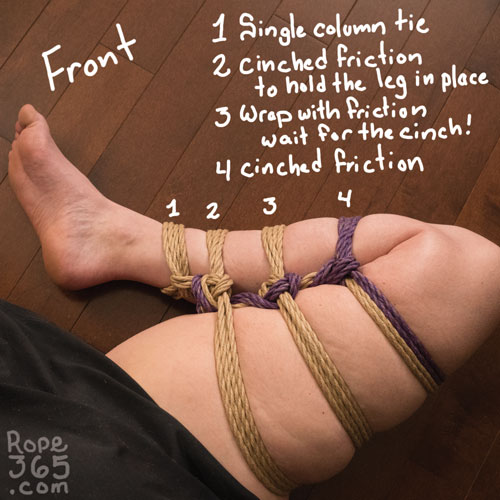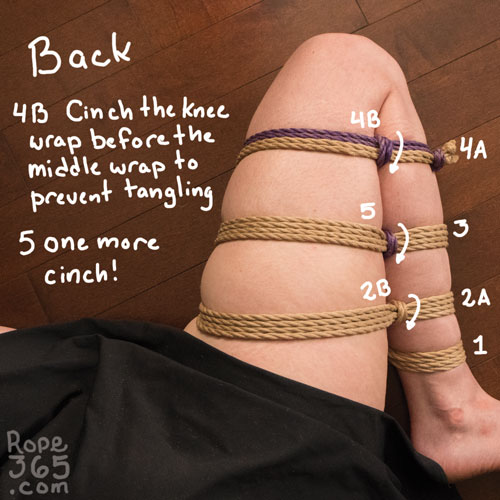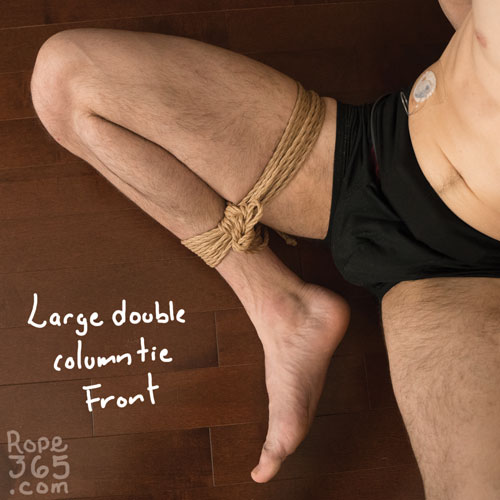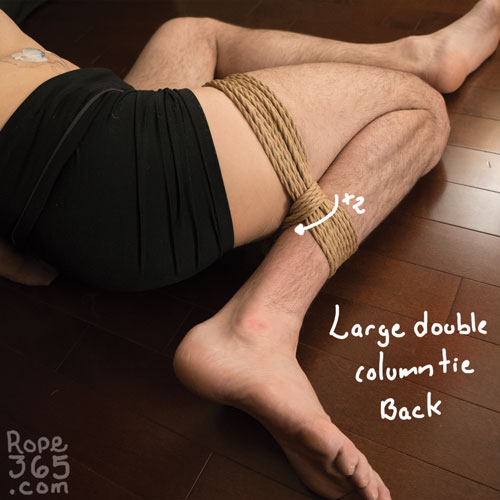Day 24: Cinches
Using the space between the calf and the tight to cinch will make the structure more sturdy. This prevents slippage, especially keeping wraps close to the knee from flipping over. It allows you to pull and play with the tie in a rougher play without compromising its integrity. This can be harder than it looks, the space can be very narrow and getting the rope through may feel like threading a needle. The rope used for cinching may add an element of discomfort as well. Solidity always comes at a cost.
Cinches in Tight Places
There are several strategies that we can use to mitigate the inconveniences of tying cinches in tight locations. These are useful for the frog tie, and also for any tie that uses cinching through a narrow spot.
- Placement: Pick where your wraps are to have enough space for your cinch. Being too close to the knee joint will force the rope in bad places.
- Go for the big gap: Insert the rope closer to the foot where there is more space, and then slide it up toward the knee.
- No crossing: Make sure the cinches don’t cross and braid in the gap. Choosing carefully the order in which we tie the cinches and the direction in which we tie can prevent this. Start from the knee and then down to the ankle.
- Avoid bulk: Make sure the rope goes into a straight line, good tension will help prevent rope from bunching up in the cinch. Avoid rope extension in the cinch.
- Maintain the position: Cinching wraps closer to the ankles will have more impact on the position than those closer to the knee. If you are making several cinched wraps, cinch the ones closer to the ankle first to lock the position in place.
This activity builds on the concepts from Day 6, you might want to review it before starting.
Practice Time!
Experiment with different strategies to add cinches to your frog tie design.
Self-evaluation checklist:
- Are there any painful sensations? In particular from overextension at the knee or on the front of the tibia bone.
- Is the leg fully bent, can the leg still move at the knee?
- Frictions are tight and compact with no undesired twists.
- Tension is even across the tie, especially the cinches.
- Are the cinches straight in the gap? Is there any bulk?
- Move the leg around, does the tie stay in place?
- Pull the stem in different directions; how does it hold?
- How is the blood circulation? Does the foot become numb after some time?
Exploration ideas:
- Try different placement of wraps.
- Different number of wraps.
- Cinch the wraps in different orders.
- Vary the tension on the cinches.
- Challenge: try cinching the same wrap several times.
- Try different approaches to minimize pinching when threading the cinch in.
Being Tied: Cinches and Pinches – sansblague
The experience of being tied up can sometimes entail unintended pinches, accidental body hair-pulling, and sudden burning sensations from rope friction against the skin. In connection to this exercise, take a moment to talk with the one tying you about how you experience these minor, unintended pains. If you are a fan of being treated roughly, find out if there is something you and your partner can do together that makes pinches, pulling, and burns feel more intended and meaningful to you both. If you are a fan of softness, find out if there is something you and your partner can do to minimize the involuntary pain experiences or make up for them (with every pinch, a kiss).
Inspirations and Resources
- Patello-Femoral Syndrome (Chondromalacia) from Floorwork Futomomo by _Estella
- Futomomo ‘box tie style’ adding suspension lines by mrluckiesrope
- Frog Tie by MonkeyFetish
- How to tie a “Frog tie” with Delano and Tam
- Ankle to Thigh Restraint by BoundJock
- Leg Wrap by Fetish Weekly
Credit: Three wrap frog tie M/R: Ebi McKnotty P: AlexK7 Large wrap frog tie M: AlexK7 R/P: Ebi McKnotty
Or return to Frog Ties for more options.





Leave a Reply